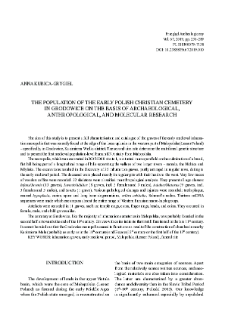- Wyszukaj w całym Repozytorium
- Piśmiennictwo i mapy
- Archeologia
- Baza Młynów
- Nauki przyrodnicze
Wyszukiwanie zaawansowane
Wyszukiwanie zaawansowane
Wyszukiwanie zaawansowane
Wyszukiwanie zaawansowane
Wyszukiwanie zaawansowane

Obiekt
Tytuł: The population of the early Polish Christian cemetery in Grodowice on the basis of archaeological, anthropological, and molecular research
Inny tytuł:
Przegląd Archeologiczny T. 67 (2019)
Wydawca:
Instytut Archeologii i Etnologii Polskiej Akademii Nauk ; Ośrodek Badań nad Kulturą Późnego Antyku i Wczesnego Średniowiecza
Miejsce wydania:
Opis:
Typ obiektu:
Abstrakt:
The aim of this study is to present a full characterization and catalogue of the graves of the early medieval inhumation necropolis that was recently found at the edge of the loess uplands in the western part of Małopolska (Lesser Poland) – specifically, in Grodowice, Kazimierza Wielka district. The second aim is to determine the matrilineal genetic structure and to present the first medieval population-level human DNA study from Małopolska. ; The necropolis, which was excavated in 2005-2008 at site 1, is situated in an open field on the culmination of a broad, flat hill being part of a longitudinal range of hills separating the valleys of two larger rivers – namely, the Nidzica and Młyńska. The excavations resulted in the discovery of 35 inhumation graves, partly arranged in regular rows, dating to the early medieval period. The deceased were placed mostly in regular pits with their heads to the west. Very few traces of wooden coffins were recorded. 32 skeletons were classified in anthropological analysis. They present all age classes: Infans/Juvenis (13 graves), Juvenis/Adultus (8 graves, incl. 3 females and 3 males), Adultus/Maturus (9 graves, incl. 3 females and 3 males), and Senilis (1 grave). Various pathological changes and injuries were recorded: teeth plaque, enamel hypoplasia, caries, spine and long bone degenerations, cribra orbitalia, Schmorl’s nodes. Thirteen mtDNA sequences were made which encompass almost the entire range of Western Eurasian macro-haplogroups. ; Artefacts were recorded in 11 graves, such as: temple rings, coins, finger rings, beads, and coins. They occurred in female, male, and child graves alike. ; The cemetery at Grodowice, like the majority of inhumation cemeteries in Małopolska, was probably founded in the second half or towards the end of the 10th century. Graves with coins indicate that it still functioned in the late 11th century. It cannot be ruled out that the Grodowice necropolis ceased to function as a result of the construction of churches in nearby Kazimierza Mała (probably as early as in the 11th century) and Bejsce (12th century or the first half of the 13th century).
Czasopismo/Seria/cykl:
Tom:
Strona pocz.:
Strona końc.:
Szczegółowy typ zasobu:
Identyfikator zasobu:
oai:rcin.org.pl:236618 ; 0079-7138 ; 67.2019.010
Źródło:
IAiE PAN, sygn. P III 149 ; IAiE PAN, sygn. P III 272 ; IAiE PAN, sygn. P III 353 ; kliknij tutaj, żeby przejść
Język:
Digitalizacja:
Instytut Archeologii i Etnologii Polskiej Akademii Nauk
Lokalizacja oryginału:
Biblioteka Instytutu Archeologii i Etnologii PAN
Dostęp:
Kolekcje, do których przypisany jest obiekt:
- Repozytorium Cyfrowe Instytutów Naukowych > Kolekcje Partnerów > Instytut Archeologii i Etnologii PAN > Publikacje Pracowników i Wydawnictwa IAE PAN
- Repozytorium Cyfrowe Instytutów Naukowych > Kolekcje Partnerów > Instytut Archeologii i Etnologii PAN > Publikacje Pracowników i Wydawnictwa IAE PAN > Czasopisma bieżące
- Repozytorium Cyfrowe Instytutów Naukowych > Piśmiennictwo > Czasopisma/Artykuły
- Repozytorium Cyfrowe Instytutów Naukowych > Kolekcje Partnerów > Instytut Archeologii i Etnologii PAN > Publikacje Pracowników i Wydawnictwa IAE PAN > Czasopisma bieżące > Przegląd Archeologiczny
Data ostatniej modyfikacji:
24 lis 2022
Data dodania obiektu:
24 lis 2022
Liczba pobrań / odtworzeń:
102
Wszystkie dostępne wersje tego obiektu:
https://rcin.org.pl/publication/124774
Wyświetl opis w formacie RDF:
Wyświetl opis w formacie RDFa:
Wyświetl opis w formacie OAI-PMH:
Obiekty Podobne
Kubica-Grygiel, Anna
Kubica-Grygiel, Anna Csáky, Veronika Mende, Balázs Gusztáv
Makiewicz, Tadeusz

 INSTYTUT ARCHEOLOGII I ETNOLOGII POLSKIEJ AKADEMII NAUK
INSTYTUT ARCHEOLOGII I ETNOLOGII POLSKIEJ AKADEMII NAUK
 INSTYTUT BADAŃ LITERACKICH POLSKIEJ AKADEMII NAUK
INSTYTUT BADAŃ LITERACKICH POLSKIEJ AKADEMII NAUK
 INSTYTUT BADAWCZY LEŚNICTWA
INSTYTUT BADAWCZY LEŚNICTWA
 INSTYTUT BIOLOGII DOŚWIADCZALNEJ IM. MARCELEGO NENCKIEGO POLSKIEJ AKADEMII NAUK
INSTYTUT BIOLOGII DOŚWIADCZALNEJ IM. MARCELEGO NENCKIEGO POLSKIEJ AKADEMII NAUK
 INSTYTUT BIOLOGII SSAKÓW POLSKIEJ AKADEMII NAUK
INSTYTUT BIOLOGII SSAKÓW POLSKIEJ AKADEMII NAUK
 INSTYTUT CHEMII FIZYCZNEJ PAN
INSTYTUT CHEMII FIZYCZNEJ PAN
 INSTYTUT CHEMII ORGANICZNEJ PAN
INSTYTUT CHEMII ORGANICZNEJ PAN
 INSTYTUT FILOZOFII I SOCJOLOGII PAN
INSTYTUT FILOZOFII I SOCJOLOGII PAN
 INSTYTUT GEOGRAFII I PRZESTRZENNEGO ZAGOSPODAROWANIA PAN
INSTYTUT GEOGRAFII I PRZESTRZENNEGO ZAGOSPODAROWANIA PAN
 INSTYTUT HISTORII im. TADEUSZA MANTEUFFLA POLSKIEJ AKADEMII NAUK
INSTYTUT HISTORII im. TADEUSZA MANTEUFFLA POLSKIEJ AKADEMII NAUK
 INSTYTUT JĘZYKA POLSKIEGO POLSKIEJ AKADEMII NAUK
INSTYTUT JĘZYKA POLSKIEGO POLSKIEJ AKADEMII NAUK
 INSTYTUT MATEMATYCZNY PAN
INSTYTUT MATEMATYCZNY PAN
 INSTYTUT MEDYCYNY DOŚWIADCZALNEJ I KLINICZNEJ IM.MIROSŁAWA MOSSAKOWSKIEGO POLSKIEJ AKADEMII NAUK
INSTYTUT MEDYCYNY DOŚWIADCZALNEJ I KLINICZNEJ IM.MIROSŁAWA MOSSAKOWSKIEGO POLSKIEJ AKADEMII NAUK
 INSTYTUT PODSTAWOWYCH PROBLEMÓW TECHNIKI PAN
INSTYTUT PODSTAWOWYCH PROBLEMÓW TECHNIKI PAN
 INSTYTUT SLAWISTYKI PAN
INSTYTUT SLAWISTYKI PAN
 SIEĆ BADAWCZA ŁUKASIEWICZ - INSTYTUT TECHNOLOGII MATERIAŁÓW ELEKTRONICZNYCH
SIEĆ BADAWCZA ŁUKASIEWICZ - INSTYTUT TECHNOLOGII MATERIAŁÓW ELEKTRONICZNYCH
 MUZEUM I INSTYTUT ZOOLOGII POLSKIEJ AKADEMII NAUK
MUZEUM I INSTYTUT ZOOLOGII POLSKIEJ AKADEMII NAUK
 INSTYTUT BADAŃ SYSTEMOWYCH PAN
INSTYTUT BADAŃ SYSTEMOWYCH PAN
 INSTYTUT BOTANIKI IM. WŁADYSŁAWA SZAFERA POLSKIEJ AKADEMII NAUK
INSTYTUT BOTANIKI IM. WŁADYSŁAWA SZAFERA POLSKIEJ AKADEMII NAUK




































